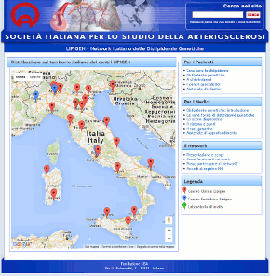 Rivista in lingua italiana
Rivista in lingua italiana
riservata ai Soci SISA
Ultimo numero:
Anno 15 • N.1/2024
SISANews
L'associazione tra circonferenza della vita e rischio di morte è indipendente dal grado di obesità
Che l'obesità centrale sia associata ad un aumento del rischio di morte è un fatto acquisito da tempo. Una nuova conferma viene da questo studio prospettico che ha coinvolto oltre 100.000 soggetti di ambo i sessi arruolati tra il 1992 ed il 1993 nell'ambito del CPS-II Nutrition Cohort. Dallo studio è emerso che la circonferenza della vita è un buon indice prognostico di mortalità per tutte le cause, indipendentemente dall'indice di massa corporea. In altri termini, anche persone non obese, ma che hanno una circonferenza della vita superiore ai 90 cm per l'uomo ed ai 75 cm per la donna hanno un rischio di morte più elevato di quello dei soggetti con circonferenza della vita minore. Il rischio relativo di morte associato ad un aumento di 10 cm della circonferenza della vita variava dal 15% al 25% nelle varie categorie di indice di massa corporea (normali, sovrappeso e obesi) ed era maggiore nelle donne che negli uomini. Quanto alle cause di morte, tutte erano rappresentate, anche se l'associazione più forte è risultata quella tra circonferenza vita e mortalità per malattie respiratorie, seguita da quella per malattie cardiovascolari e tumori.
![]()
Waist circumference and all-cause mortality in a large US cohort
Jacobs EJ, Newton CC, Wang Y, Patel AV, McCullough ML, Campbell PT, Thun MJ, Gapstur SM.
Arch Intern Med 2010;170:1293-301
BACKGROUND: Waist circumference (WC), a measure of abdominal obesity, is associated with higher mortality independent of body mass index (BMI). Less is known about the association between WC and mortality within categories of BMI or for the very high levels of WC that are now common.
METHODS: We examined the association between WC and mortality among 48,500 men and 56,343 women, 50 years or older, in the Cancer Prevention Study II Nutrition Cohort. A total of 9315 men and 5332 women died between 1997 and the end of follow-up in 2006.
RESULTS: After adjustment for BMI and other risk factors, very high levels of WC were associated with an approximately 2-fold higher risk of mortality in men and women (among men, relative risk [RR]=2.02; 95% confidence interval [CI], 1.71-2.39 for WC>or=120 cm compared with <90 cm; among women, RR=2.36; 95% CI, 1.98-2.82 for WC>or=110 cm compared with <75 cm). The WC was positively associated with mortality within all categories of BMI. In men, a 10-cm increase in WC was associated with RRs of 1.16 (95% CI, 1.09-1.23), 1.18 (95% CI, 1.12-1.24), and 1.21 (95% CI, 1.13-1.30) within normal (18.5 to <25), overweight (25 to <30), and obese (>or=30) BMI categories, respectively. In women, corresponding RRs were 1.25 (95% CI, 1.18-1.32), 1.15 (95% CI, 1.08-1.22), and 1.13 (95% CI, 1.06-1.20).
CONCLUSION: These results emphasize the importance of WC as a risk factor for mortality in older adults, regardless of BMI.
Arch Intern Med 2010;170:1293-301

Area Soci
Eventi


 SISA LIPID ACADEMY - Corso avanzato di lipidologia clinica
SISA LIPID ACADEMY - Corso avanzato di lipidologia clinicaModena, 4-5 Luglio 2024
[continua a leggere]



Giornale Italiano Arteriosclerosi
HoFH today
 Rivista Italiana della
Rivista Italiana della
Ipercolesterolemia
Familiare Omozigote
Anno 5 • N.1/2023
Rivista NMCD
Diateca
[continua a leggere]
[continua a leggere]
Newsletter
il vostro indirizzo di posta elettronica
Progetto LIPIGEN

Nuovo sito dedicato al Progetto LIPIGEN
Progetto LIPIGEN - Vecchio portale
E' necessario essere loggati come utente
Lipigen per poter accedere alla pagina
PROject Statin Intolerance SISA
PROSISA – PROject Statin Intolerance SISA
E' necessario essere loggati come utente
PROSISA per poter accedere alla pagina
GILA - Lipoprotein Aferesi
Gruppo Interdisciplinare Lipoprotein Aferesi
(Accesso Gruppo GILA-Lipoprotein Aferesi)
E' necessario essere loggati come utente del Gruppo GILA per poter accedere
Gruppo Interdisciplinare Lipoprotein Aferesi
(Documentazione ad accesso libero)
Pagina informativa per medici e pazienti














